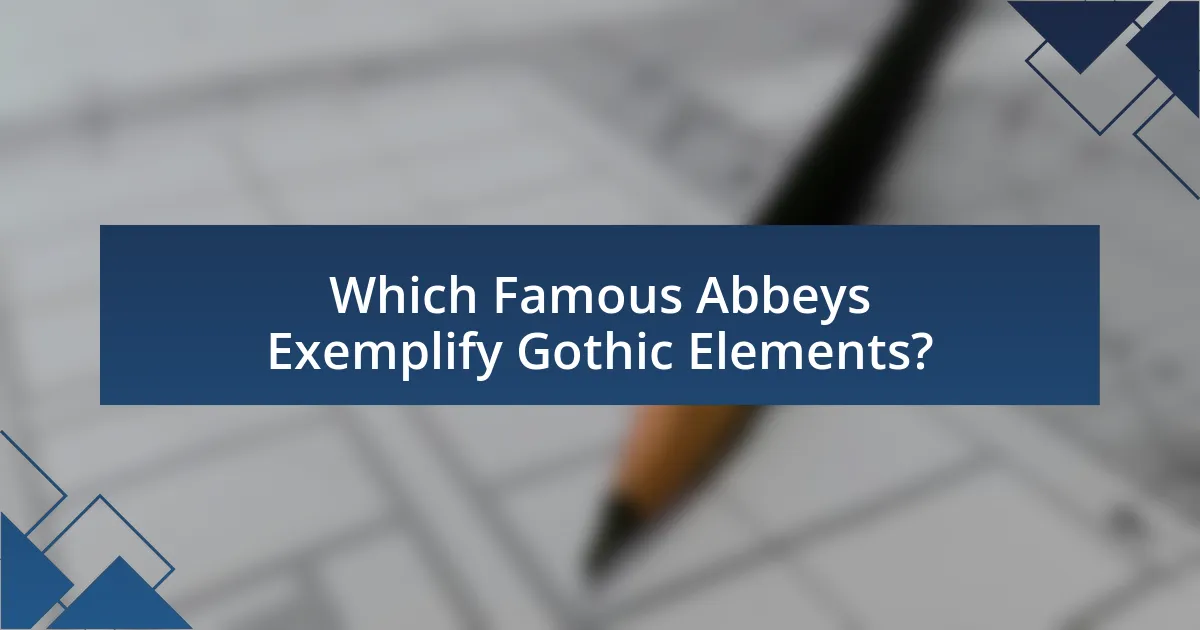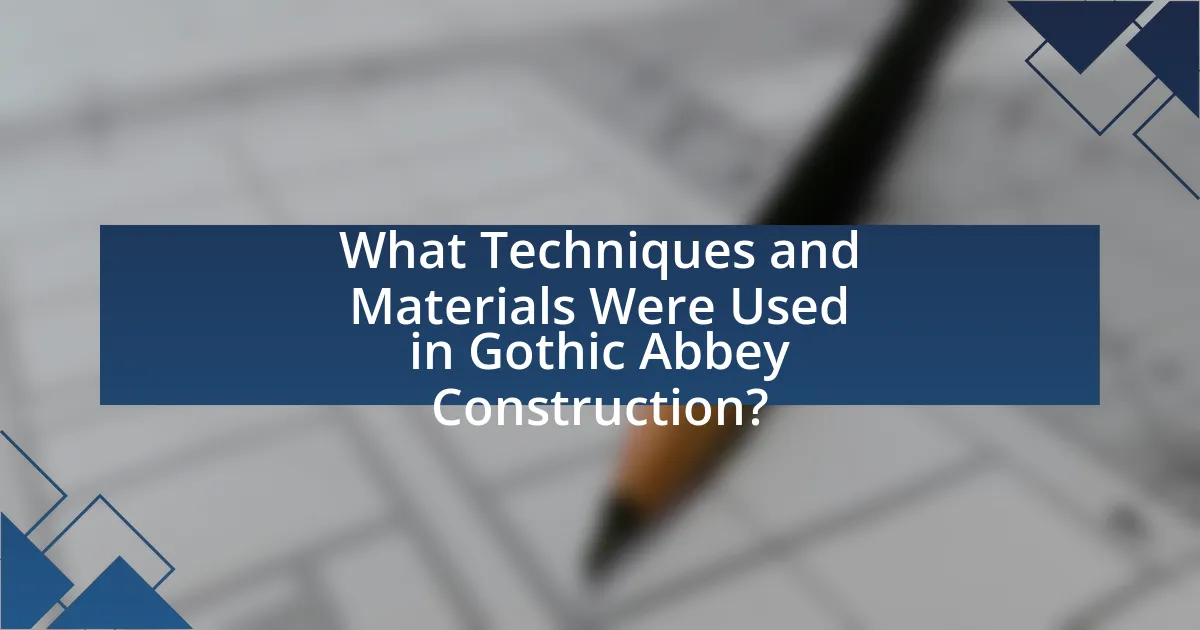The article explores the Gothic elements present in Europe’s most renowned abbeys, highlighting architectural features such as pointed arches, ribbed vaults, flying buttresses, and stained glass windows. It examines how Gothic architecture influenced abbey design, emphasizing the significance of these structures in reflecting cultural and religious values during the Middle Ages. Notable examples, including the Abbey of Saint-Denis and Westminster Abbey, are discussed in terms of their unique characteristics and historical context. The article also addresses the construction techniques and materials used in Gothic abbeys, as well as best practices for visiting and appreciating these architectural masterpieces.
What are the Gothic Elements Found in Europe’s Most Famous Abbeys?
Gothic elements found in Europe’s most famous abbeys include pointed arches, ribbed vaults, flying buttresses, and intricate stained glass windows. These architectural features exemplify the Gothic style that emerged in the 12th century, characterized by verticality and light. For instance, the Abbey of Saint-Denis in France, often considered the first Gothic structure, showcases these elements prominently, influencing subsequent abbeys like Westminster Abbey in England and the Abbey of Saint-Germain-des-Prés. The use of flying buttresses allowed for higher ceilings and larger windows, which were filled with elaborate stained glass that depicted biblical stories, enhancing the spiritual experience within these sacred spaces.
How did Gothic architecture influence the design of abbeys?
Gothic architecture significantly influenced the design of abbeys by introducing structural innovations such as pointed arches, ribbed vaults, and flying buttresses, which allowed for taller and more light-filled spaces. These elements enabled abbeys to feature expansive stained glass windows, enhancing the spiritual atmosphere within. Notable examples include the Abbey of Saint-Denis, where Abbot Suger implemented these Gothic principles in the 12th century, marking a shift from Romanesque to Gothic styles. This transformation not only improved the aesthetic appeal but also facilitated the construction of larger naves and transepts, which became characteristic of Gothic abbey design.
What are the key characteristics of Gothic architecture in abbeys?
The key characteristics of Gothic architecture in abbeys include pointed arches, ribbed vaults, flying buttresses, and large stained glass windows. Pointed arches allow for greater height and stability, while ribbed vaults enable the construction of expansive ceilings. Flying buttresses provide external support, allowing walls to be thinner and filled with large windows, which are often adorned with intricate stained glass that illuminates the interior with colored light. These elements collectively create a sense of verticality and lightness, which are hallmarks of the Gothic style, as seen in famous examples like the Abbey of Saint-Denis and Westminster Abbey.
How do these characteristics manifest in specific abbeys?
Gothic characteristics manifest in specific abbeys through architectural features, decorative elements, and spatial organization. For example, the Abbey of Saint-Denis in France showcases pointed arches, ribbed vaults, and flying buttresses, which are hallmark traits of Gothic architecture. These elements not only enhance structural stability but also create an ethereal quality through the use of stained glass windows that flood the interior with light, exemplifying the transition from Romanesque to Gothic styles. Similarly, Westminster Abbey in England features intricate stone carvings and a grand nave that reflects the verticality and grandeur typical of Gothic design, emphasizing the spiritual aspirations of the period. The use of large windows in both abbeys allows for a dramatic interplay of light and color, reinforcing the connection between the divine and the architectural space.
Why are abbeys significant in the context of Gothic architecture?
Abbeys are significant in the context of Gothic architecture because they exemplify the style’s key characteristics, such as verticality, light, and intricate detailing. Gothic abbeys, like the Abbey of Saint-Denis in France, pioneered the use of ribbed vaults and flying buttresses, which allowed for higher ceilings and larger windows, enhancing the sense of space and light. These architectural innovations not only defined the aesthetic of the Gothic period but also served practical purposes, enabling the construction of expansive naves and clerestories that flooded interiors with natural light, a crucial element in Gothic design. The historical importance of abbeys is further underscored by their role as centers of monastic life and cultural preservation during the Middle Ages, contributing to the spread of Gothic architecture across Europe.
What role did abbeys play in the development of Gothic style?
Abbeys were pivotal in the development of the Gothic style by serving as centers for architectural innovation and religious expression. The construction of abbeys, particularly from the 12th century onward, showcased the use of pointed arches, ribbed vaults, and flying buttresses, which became hallmarks of Gothic architecture. Notable examples include the Abbey of Saint-Denis, where Abbot Suger initiated the use of these elements to enhance the spiritual experience and light within the church, influencing subsequent Gothic structures across Europe. The emphasis on verticality and light in abbey designs reflected the theological aspirations of the time, aiming to create a heavenly atmosphere that drew the faithful closer to God.
How do abbeys reflect the cultural and religious values of their time?
Abbeys reflect the cultural and religious values of their time through their architectural design, artistic elements, and the monastic practices they embody. For instance, the intricate Gothic architecture of abbeys, characterized by pointed arches, ribbed vaults, and flying buttresses, symbolizes the era’s emphasis on spirituality and the divine, aiming to inspire awe and reverence among worshippers. Additionally, the artwork within abbeys, such as stained glass windows and sculptures, often depicts biblical narratives and saints, reinforcing the religious teachings and moral values of the period. Historical examples include the Abbey of Saint-Denis, which served as a royal burial site and a center for the promotion of the monarchy’s divine right, illustrating how abbeys functioned as both spiritual and political symbols in medieval society.

Which Famous Abbeys Exemplify Gothic Elements?
Famous abbeys that exemplify Gothic elements include the Abbey of Saint-Denis in France, Westminster Abbey in England, and the Abbey of Saint-Germain-des-Prés, also in France. The Abbey of Saint-Denis, constructed in the 12th century, is recognized as the first Gothic structure, featuring ribbed vaults and pointed arches. Westminster Abbey, with its intricate flying buttresses and large stained glass windows, showcases classic Gothic architecture and has been the site of numerous royal ceremonies since the 11th century. The Abbey of Saint-Germain-des-Prés, dating back to the 6th century, incorporates Gothic elements in its later renovations, particularly in its soaring ceilings and detailed stonework. These abbeys collectively illustrate the defining characteristics of Gothic architecture, such as verticality, light, and elaborate ornamentation.
What are the most renowned Gothic abbeys in Europe?
The most renowned Gothic abbeys in Europe include the Abbey of Saint-Denis in France, the Abbey of Westminster in England, and the Kloster Eberbach in Germany. The Abbey of Saint-Denis, constructed in the 12th century, is considered the first Gothic building and served as a prototype for later Gothic architecture. Westminster Abbey, with its origins dating back to the 10th century, showcases stunning Gothic elements and has been the site of numerous royal ceremonies. Kloster Eberbach, founded in 1136, is notable for its well-preserved Gothic structures and historical significance in the wine industry. These abbeys exemplify the key characteristics of Gothic architecture, such as pointed arches, ribbed vaults, and flying buttresses.
What unique features do these abbeys showcase?
These abbeys showcase unique features such as intricate Gothic architecture, including pointed arches, ribbed vaults, and flying buttresses. For instance, the Abbey of Saint-Denis, considered the first Gothic structure, exemplifies these elements with its innovative use of light and space, achieved through large stained glass windows. Additionally, many abbeys feature elaborate sculptures and carvings that depict biblical scenes, enhancing their spiritual significance and artistic value. The combination of these architectural and artistic elements not only defines the Gothic style but also reflects the cultural and religious aspirations of the period.
How do these abbeys compare to one another in terms of Gothic elements?
The abbeys exhibit varying degrees of Gothic elements, with notable differences in architectural features, ornamentation, and structural innovations. For instance, Chartres Abbey is renowned for its intricate stained glass windows and flying buttresses, which exemplify the height and light characteristic of Gothic architecture. In contrast, Westminster Abbey showcases a more subdued use of Gothic elements, emphasizing ribbed vaults and pointed arches, yet it lacks the extensive use of light found in Chartres. Additionally, the Abbey of Saint-Denis is significant for its pioneering use of the Gothic style, featuring the first ribbed vaults and pointed arches, which set a precedent for later structures. These distinctions highlight how each abbey interprets and implements Gothic elements, reflecting regional styles and historical contexts.
How do historical events shape the architecture of these abbeys?
Historical events significantly shape the architecture of abbeys by influencing their design, materials, and structural features. For instance, the Gothic architectural style emerged in the 12th century during a period of religious fervor and societal change, leading to the construction of abbeys with pointed arches, ribbed vaults, and flying buttresses to create grand, vertical spaces that inspired awe and reflected the power of the Church. The construction of the Abbey of Saint-Denis in France, initiated by Abbot Suger in the 1140s, exemplifies this influence, as it marked the transition to Gothic architecture, driven by the desire to enhance the spiritual experience and accommodate growing congregations. Additionally, historical events such as the Crusades and the rise of monastic orders prompted the need for larger, more fortified structures, further shaping the architectural evolution of abbeys across Europe.
What major historical events influenced the construction of specific abbeys?
The construction of specific abbeys was significantly influenced by major historical events such as the Norman Conquest of 1066, the Crusades from the late 11th to the 13th centuries, and the rise of monastic reform movements in the 10th century. The Norman Conquest led to the establishment of numerous abbeys in England, as William the Conqueror sought to consolidate power and promote Christianity, resulting in the construction of notable abbeys like Westminster Abbey. The Crusades stimulated the growth of monastic communities, as returning knights and pilgrims funded the building of abbeys to commemorate their journeys, exemplified by the Abbey of Saint-Denis in France, which became a model for Gothic architecture. Additionally, the Cluniac reform movement in the 10th century emphasized the need for monastic renewal, leading to the establishment of abbeys that adhered to stricter religious practices, such as Cluny Abbey in Burgundy, which became a center of influence for monastic architecture and spirituality.
How did these events impact the preservation of Gothic elements?
The events significantly impacted the preservation of Gothic elements by fostering a renewed interest in medieval architecture and art. This resurgence was driven by cultural movements such as the Gothic Revival in the 19th century, which emphasized the aesthetic and historical value of Gothic structures. For instance, the restoration efforts of iconic buildings like Notre-Dame Cathedral in Paris and Westminster Abbey in London highlighted the importance of maintaining Gothic features, leading to the preservation of intricate stonework, stained glass, and ribbed vaults. These initiatives not only safeguarded the physical structures but also reinforced the cultural identity associated with Gothic architecture, ensuring its legacy for future generations.

What Techniques and Materials Were Used in Gothic Abbey Construction?
Gothic abbey construction utilized techniques such as ribbed vaulting, flying buttresses, and pointed arches, alongside materials like limestone, granite, and stained glass. Ribbed vaulting allowed for the distribution of weight, enabling higher ceilings and more complex designs. Flying buttresses provided external support, allowing walls to be thinner and filled with large stained glass windows, which were integral to the aesthetic and spiritual experience of the abbey. The use of durable materials like limestone and granite ensured the longevity of these structures, while stained glass not only enhanced beauty but also served to convey biblical stories to the largely illiterate population of the time.
What construction techniques are characteristic of Gothic abbeys?
Gothic abbeys are characterized by several distinctive construction techniques, including the use of pointed arches, ribbed vaults, and flying buttresses. Pointed arches allow for greater height and stability, enabling the construction of taller structures with larger windows. Ribbed vaults distribute weight more efficiently, allowing for expansive ceilings and intricate designs. Flying buttresses provide external support, transferring the weight of the roof and walls away from the structure, which permits the inclusion of large stained glass windows that are a hallmark of Gothic architecture. These techniques collectively contribute to the ethereal quality and grandeur of Gothic abbeys, exemplified in structures like the Abbey of Saint-Denis and Chartres Cathedral.
How did these techniques enhance the structural integrity of abbeys?
The techniques used in Gothic architecture, such as ribbed vaults, flying buttresses, and pointed arches, significantly enhanced the structural integrity of abbeys. Ribbed vaults distributed weight more evenly across the structure, allowing for taller and more stable ceilings. Flying buttresses provided external support, countering lateral forces and enabling the construction of larger windows, which reduced wall thickness without compromising stability. Pointed arches allowed for greater height and flexibility in design, effectively managing the forces acting on the structure. These innovations collectively resulted in abbeys that were not only aesthetically impressive but also structurally sound, as evidenced by the enduring nature of many Gothic abbeys that have withstood the test of time.
What innovations in construction emerged during the Gothic period?
Innovations in construction during the Gothic period include the development of the ribbed vault, flying buttress, and pointed arch. The ribbed vault allowed for the distribution of weight more efficiently, enabling taller and more complex structures. The flying buttress provided external support, allowing walls to be thinner and filled with large stained glass windows, which became a hallmark of Gothic architecture. The pointed arch not only enhanced structural stability but also allowed for greater height and the creation of intricate designs. These innovations collectively transformed the architectural landscape of Europe, exemplified in structures like Notre-Dame Cathedral and Chartres Cathedral.
What materials were predominantly used in the construction of Gothic abbeys?
Gothic abbeys were predominantly constructed using stone, particularly limestone and sandstone. These materials were favored for their durability and availability, allowing for the intricate architectural designs characteristic of the Gothic style, such as flying buttresses and ribbed vaults. Historical examples, such as the Abbey of Saint-Denis in France, illustrate the use of these stones, which provided both structural integrity and aesthetic appeal, enabling the grand scale and detailed ornamentation typical of Gothic architecture.
How did the choice of materials affect the aesthetic of the abbeys?
The choice of materials significantly influenced the aesthetic of the abbeys by enhancing their grandeur and structural integrity. For instance, the use of limestone and granite in Gothic architecture allowed for intricate carvings and soaring facades, which contributed to the verticality and lightness characteristic of the style. Additionally, stained glass windows, made from colored glass, not only illuminated the interiors but also created a vibrant play of light, enhancing the spiritual atmosphere within the abbeys. The combination of these materials resulted in visually striking structures that conveyed both religious significance and artistic expression, exemplified by the intricate details found in the Abbey of Saint-Denis and the soaring heights of Chartres Cathedral.
What regional variations exist in the materials used across Europe?
Regional variations in materials used across Europe include limestone in France, sandstone in Germany, and granite in Scotland. French Gothic cathedrals, such as Notre-Dame, prominently feature limestone sourced from local quarries, which allows for intricate carvings and a lighter appearance. In contrast, German Gothic structures, like Cologne Cathedral, utilize sandstone, providing durability and a distinct color palette. Scottish Gothic architecture, exemplified by St. Giles’ Cathedral, often incorporates granite, known for its strength and resistance to weathering. These material choices reflect local geological resources and influence the architectural styles and aesthetics of the respective regions.
What are the best practices for visiting and appreciating Gothic abbeys?
The best practices for visiting and appreciating Gothic abbeys include researching their historical significance, observing architectural details, and being respectful of the sacred environment. Understanding the historical context, such as the role of abbeys in medieval society, enhances appreciation; for instance, many Gothic abbeys were centers of learning and spirituality. Observing architectural features like pointed arches, ribbed vaults, and flying buttresses allows visitors to appreciate the engineering marvels of the Gothic style, exemplified by structures like the Abbey of Saint-Denis, which influenced the development of Gothic architecture. Lastly, maintaining a respectful demeanor, such as speaking softly and adhering to any guidelines provided by the abbey, ensures a positive experience for both visitors and the community.





